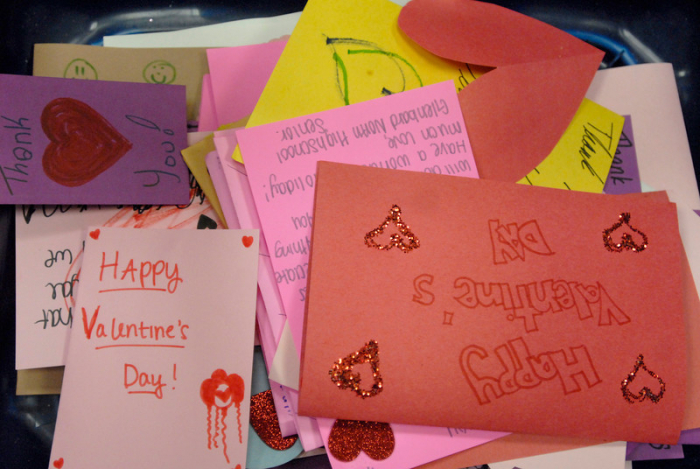While a fun diversion for kids, especially if they persuaded their caregivers to splurge on cards that include stickers or glow sticks, parents have complained about the custom for years. Many adults may wonder how a holiday ostensibly meant to celebrate romance was usurped by children. More importantly though, they may ask: Why do we give Valentine’s Day cards anyway?
The custom of trading valentines seems to have begun in Europe and the United States in the 18th century, but some legends attribute the exchange of affectionate greetings to St. Valentine himself. Valentine may have been the name of one or two martyred Christians: one is said to have been a priest and physician in Rome and the other a bishop in Terni, Italy. Both are said to have been executed on February 14 about the year 270 and could very well have been the same person. In any case, stories describe how Valentine was condemned to death for defying the emperor by secretly marrying couples to spare the husbands from war. Valentine, while in prison, allegedly befriended (or, in some versions of the story, fell in love with) his jailer’s daughter, whom he also miraculously cured of blindness. The night before his execution, he is said to have written her a farewell message and signed off with “Your Valentine.”
However fitting the tale of Valentine’s message may seem, it did not immediately initiate the tradition of sending Valentine’s Day greetings. Indeed, Valentine’s Day did not even become a holiday until the 5th century, when Pope Gelasius I purportedly needed a convenient holiday to replace the Roman festival of Lupercalia. Taking place in mid-February, Lupercalia was known for its excessive merriment and such distinctive fertility rituals as the lashing of women by men using the hides of sacrificed animals. Gelasius, perhaps in an effort to end such pagan festivities, inaugurated a feast day to commemorate Valentine on the saint’s execution date. February 14, however, was not yet observed as a day to celebrate love. Scholars believe it did not become such until nearly 1,000 years later, some asserting that Geoffrey Chaucer’s poem The Parlement of Foules first connected the day with romance. The first letters between lovers referring to St. Valentine’s Day began to appear soon after the poem’s publication in the 14th century.
Early Valentine’s Day cards, however, were not necessarily limited to couples. Indeed, some historians suggest that valentines come from the German tradition of friendship cards. Freundschaftskarten, as they are called, were traded during New Year’s Day, birthdays, and other anniversaries. This tradition had a long history itself, dating back to ancient Egypt and China, where friends exchanged gifts for the new year. Sometime in the 18th century, Europeans and Americans began exchanging friendship cards on Valentine’s Day. The practice increased in the mid-19th century, especially in England, where the introduction of the penny post made sending valentines more affordable. Meanwhile, printing technology improved and expanded the market. Consumers in Europe and the U.S. could choose from a wide selection of valentines, including those designed by the popular English illustrator Kate Greenaway and engravings by the printers Thomas W. Strong and Robert H. Elton. Esther Howland’s popular handmade collages were assembled in Massachusetts by her female employees, whom she paid a fair wage—one of the first entrepreneurs to do so.
The exchange of valentines continued into the 20th century. Examples in the collections of such institutions as the New York Public Library often bear the message “To my Valentine,” the inverse of the sign-off St. Valentine purportedly wrote, and show the popularity of cards printed in Germany. They also reveal a variety of senders and receivers. Some cards suggest a message between lovers; other cards show a note from a grandmother, a greeting addressed to an uncle, or a friendly correspondence between old chums. Classroom exchanges were also documented in the United States about this time, with students trading homemade cards. By mid-century, boxed punch-out cards were readily available, thus cementing an American tradition. Meanwhile, manufacturers such as Hallmark began selling inexpensive cards with innovative animation, three-dimensional effects, and custom-sized envelopes. Their affordability helped popularize the custom of exchanging cards for anniversaries and holidays, and Valentine’s Day cards soon became the biggest seller after Christmas. In 2018 consumers spent about one billion dollars on valentines.
Yes, Valentine’s Day cards are big business, but at their heart is a long-standing playful tradition between couples, friends, family members, and classmates to express their affection. So why not embrace the classroom exchange and let your kids get that Star Wars pack with the glow sticks while you’re at it?
Read the original article on britannica.com.
More about: ValentineCards
















































